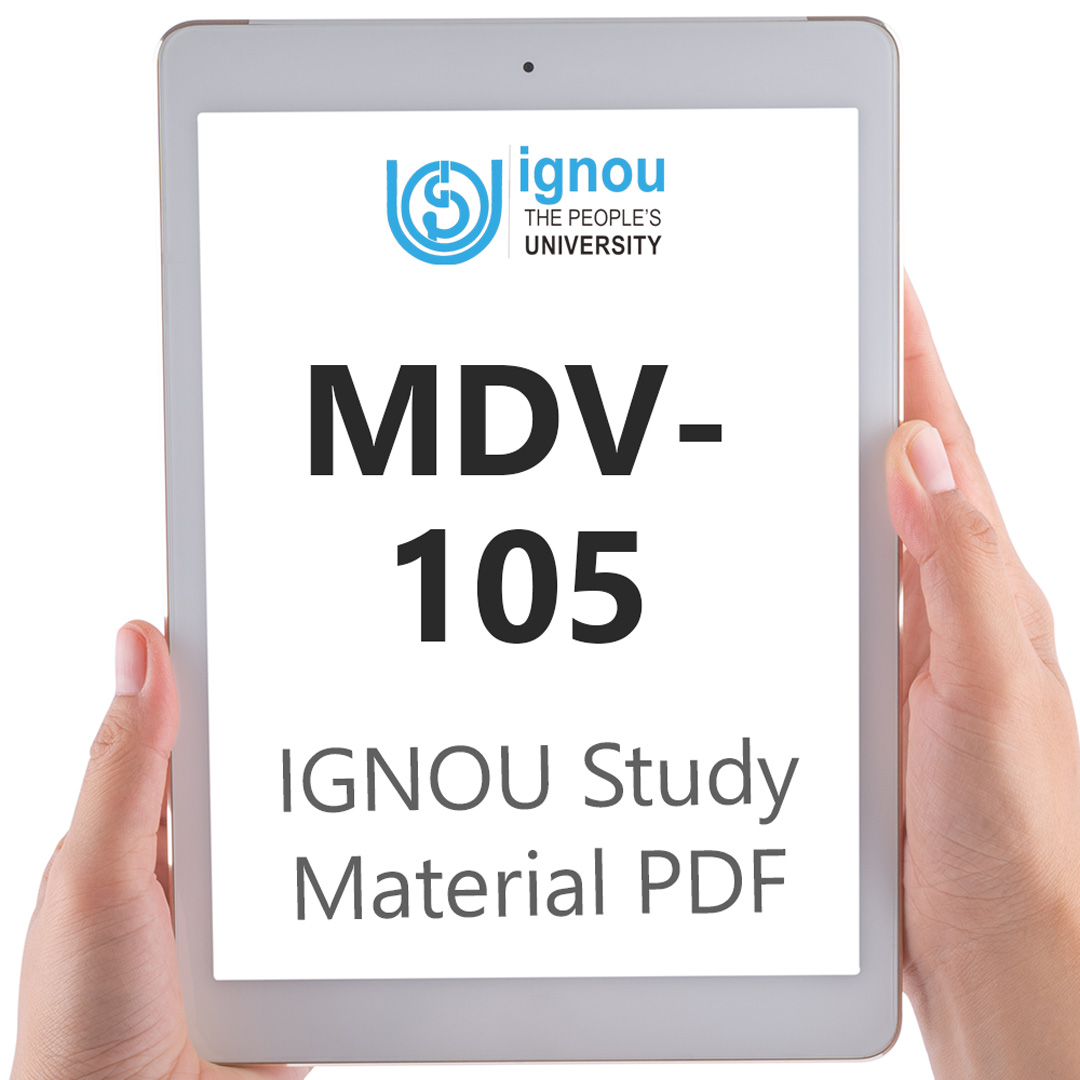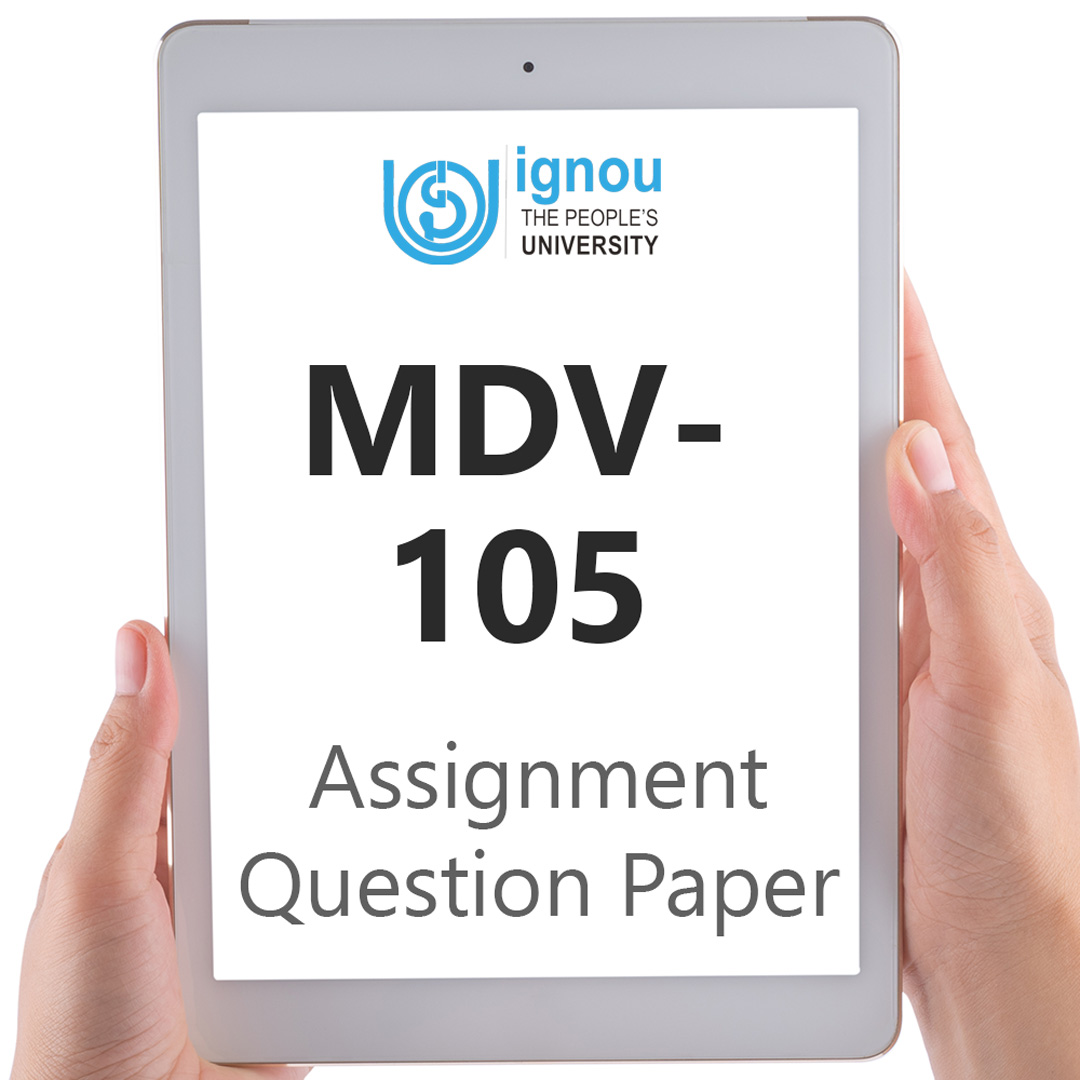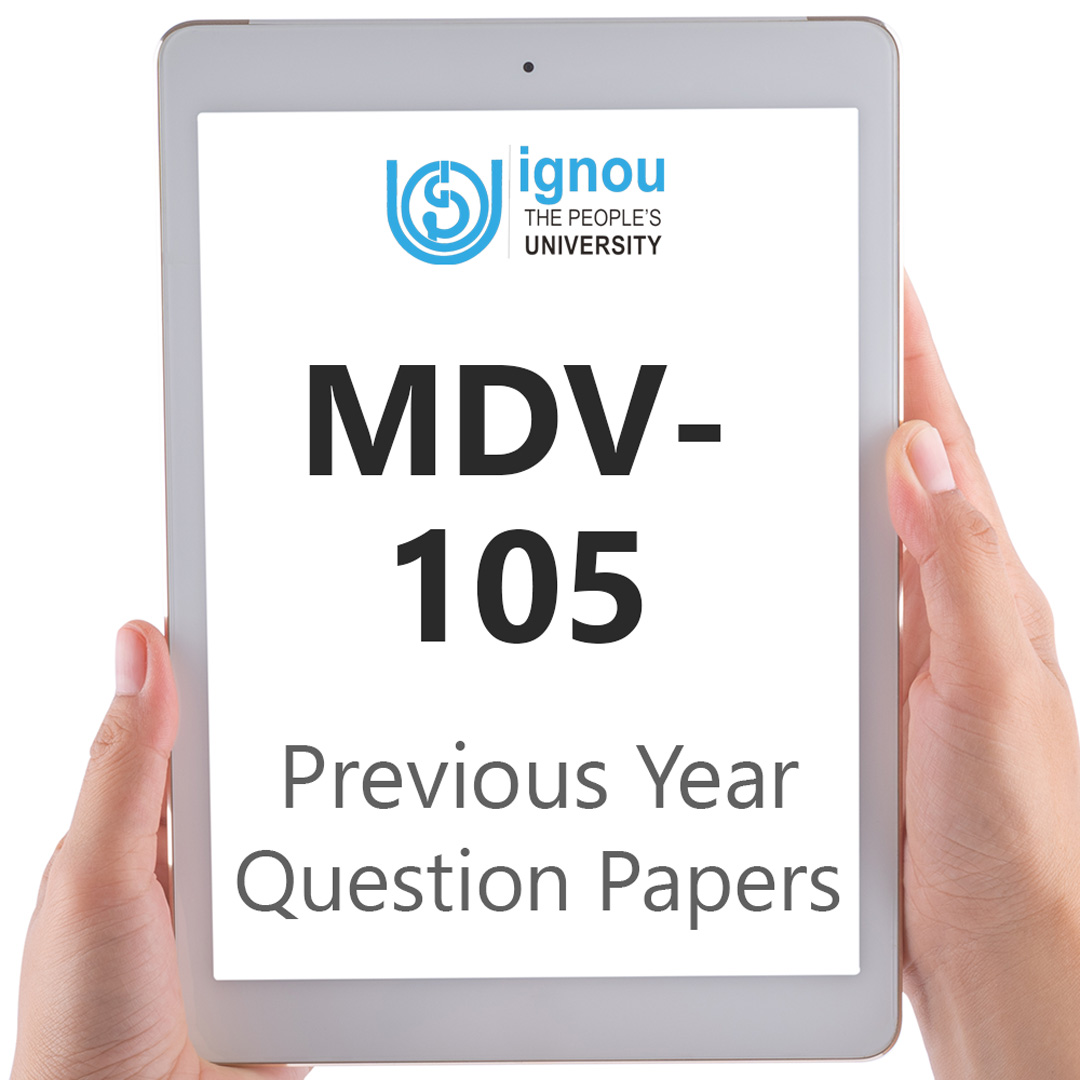If you are looking for MDV-105 IGNOU Solved Assignment solution for the subject Development Planning and Management, you have come to the right place. MDV-105 solution on this page applies to 2022-23 session students studying in MADVS courses of IGNOU.
MDV-105 Solved Assignment Solution by Gyaniversity
Assignment Code: MDV-105/ASST/TMA/2022-23
Course Code: MDV-105
Assignment Name: Development Planning and Management
Year: 2022-2023
Verification Status: Verified by Professor
Answer all the questions. All questions carry 20 marks each.
1. How to formulate programmes based on identified needs of the people? Explain with an example from any development sector.
Ans) only insofar as they are focused on the population's most pressing needs and successful in helping the population to achieve those needs. People only participate in development programmes when they think it will help them address known personal, family, group, or community problems. As a result, the need component and need identification should be the main priorities of development programmes. In other words, individuals only give attention to development programmes when their own needs and not those of programme planners are taken into account.
By effectively identifying what people want and think they need, a realistic, well-structured, and concentrated set of potent developmental activities—more properly referred to as a program—is established. Effective change-promotion programmes are developed by identifying people's needs and planning actions to assist solve them. Therefore, having a profound awareness of the nature and importance of people's needs in development efforts is vital for extension and development specialists like you. The extension programmes that are designed with the needs of the people, by the people, and for the people in mind are the most successful ones.
The state of being in need is characterised by the absence of anything thought essential for development. In needs assessment surveys, a need is often described as something that is specifically relevant to the growth of a group or a community. "Need" is a distinct term from "want," which expresses a desire for something. Fear cautioned against conflating clients' needs and desires when eliciting their wants. When we conduct needs assessments, we identify the disparity or gap between the community's present position and its desired state. As a result, "need" describes the disparity or conflict between a desired goal and the present situation (what is). Please understand that the need is not the state itself, but rather the area between the present and the future.
Sukanya Samriddhi Yojna (SSY)
Developed as part of the government's 'Beti Bachao, Beti Padhao' campaign, Sukanya Samriddhi Yojana or SSY is a welfare scheme designed for the girl child. Investing in this child insurance plan allows parents or legal guardians to ensure financial security for a girl child aging ten years or below. Under the Sukanya Samriddhi Yojana, an account in the name of the girl can be opened across any of the private and public sector banks for 21 years. The tenure of investment under SSY is 21 years, starting from the account's opening date. Sukanya Samriddhi Yojana is a saving scheme of Government of India aimed at betterment of girl child in the country. Sukanya Samriddhi Yojana is launched to provide a bright future for the girl child and enables parents to build a fund for the future education and marriage expenses of their girl child.
Sukanya Samriddhi Yojana, also referred to as SSY, is a deposit scheme made especially for the girl child. This scheme was introduced to ensure a financially secure future for the girl child. Narendra Modi launched the Sukanya Samridhi scheme, under the ‘Beti Bacho, Beti Padhao’ campaign on 22nd January 2015. The aim of this scheme is to meet the education and marriage expenses of a girl child.
Features
It permits opening of one account per girl child. A family can have a maximum two accounts, if there are 2 girl children.
However, a third account can also be opened, provided ..
Benefits
1 lakh accident insurance cover, and Rs. 30,000 life insurance cover for those who opened bank accounts before January 26th
4% interest per annum on money deposit
No criteria for minimum balance
Money can be transferred to any account in India
You can get money of government schemes directly in your bank account
Overdraft facility up to Rs. 5,000 is available after operating bank account for 6 months
2. What is the difference between effectiveness and efficiency of monitoring? Discuss different types of monitoring.
Ans) Difference between effectiveness and efficiency of monitoring as follows:
Types of Monitoring
Monitoring can be divided into two types:
Beneficiary Contact Monitoring: The success of overall project monitoring depends on effective Beneficiary Contact Monitoring. The first major part of a management information system, physical and financial monitoring, often assesses the provision and delivery of services and inputs for a project. Project managers must understand how their services are being utilised and whether they are being welcomed, for instance, into the farming community.
Monitoring of beneficial contacts is implemented:
To keep records for each participant (creditability, health, education, nutrition, and similar projects) and to conduct periodic analyses of these information in order to track the uptake of the service and the development of a clientele.
To set up a routine survey schedule that would allow managers to gauge a project's success and the beneficiaries' reactions. To obtain data from these surveys that are statistically significant, formal sampling techniques must be applied.
To educate management of extraordinary success stories or problems through informal interviews.
Process Monitoring: The first step in a project's implementation is the allocation of resources and inputs to produce a certain outcome. Certain techniques, actions, and the conclusion of specific events will be required for the conversion of inputs into outputs.
The sequence of events is as follows:
Process: It is the manner in which things are done. Processes are ongoing and span multiple activities.
Milestones: A stage in an activity can be completed by a series of these accomplishments.
Activities: These are the things we perform to produce the result. Activities are always accompanied by numbers connected to a budget and have a start and finish date.
Output: Before the project is finished, this is what a project delivers.
An approach called process monitoring makes sure that processes are directed to produce the desired outcomes and that quality is maintained throughout. Process monitoring would be beneficial and effective as long as attention is paid to both the inputs and outputs as well as the manner in which the outputs are delivered, and quality indicators are developed and monitored.
Process monitoring and traditional progress monitoring are frequently confused. While process monitoring deals with crucial processes that are directly related to the project's goals, traditional progress monitoring concentrates on the physical, financial, and logistical aspects of projects. Progress monitoring, for instance, examines the quantity of training sessions held or the proportion of a water supply scheme's work that has been completed, whereas Process Monitoring assesses the calibre of training or the extent of community involvement in project identification, design, site selection, and construction supervision. Both progress and process monitoring components are present in a perfect M&E system.
Process monitoring provides project management with information about the type of adjustments required to enhance project responsiveness to community requests, maximise effect, and increase the possibility of sustainable outcomes. It assesses the effectiveness and efficacy of project interventions and results.
3. Write the basic rules for preparing networks with the help of diagrams.
Ans) Some fundamental guidelines for setting up networks are described here with graphics for your convenience.
1) An arrow that is drawn from left to right denotes activity. The direction of the arrow or its length are irrelevant. An event is the beginning and end of every activity.
2) An event may lead to a variety of activities. This occurrence is known as a burst event.
3) An event may include a variety of activities.
4) It is incorrect to portray two or more activities as merged activities when they must be finished before the next event takes place, as is done in the example here. Introducing the dummy activity as shown in the diagram will allow this to be represented as a sequential activity.
It is recommended to assign numbering according to D.R. Fulkerson's criteria, as shown below.
a) It is recommended to begin the initial event with 1.
b) Get rid of all events number 1's spinoff activities and assign number 2 to the next event. Give 2, 3, 4, and so on for consecutive events if two or more events follow the first one simultaneously.
c) Remove all the actions that result from events 2, 3, 4, and so forth, and assign new event numbers 5, 6, and so forth.
d) Till the entire network is finished, keep doing this.
This procedure is repeated until the network with all of the event numbers is finished.
5) An event won't happen until all the activities that will combine into it are finished. The EST and LST are displayed on the right half of the circle, and event numbers are displayed in the left half.
6) The amount of time needed for each task is given after the network has been drawn.
4. What do you mean by levels of management? Describe the levels of management and managerial skills required at each level.
Ans) As it relates to development, the term "Levels of Management" refers to a boundary between different managerial positions in a developmental organisation. When the size of the development work and workforce grows, so does the number of management levels, and vice versa. In a developing organisation, the degree of management determines the chain of command, the scope of the position's authority, and its social standing.
Levels of Management
Top Level of Management: The top management oversees goals and policies and is the ultimate source of power. It spends more time coordinating and planning tasks. Examples include the CEO, managing director, and the board of directors.
The top management's duties include:
Establishing goals, broad policies, and strategic plans.
Instructions for creating schedules, budgets, and other documents.
Appointing development managers in the middle level.
Control and coordination of all departments' activity.
Middle Level of Management: They spend more time performing organisational and guiding tasks. There is only one layer of middle level management in small development organisations, although senior and junior middle level management may exist in large organisations.
Their function can be highlighted by:
Execution of strategies in conformity with upper management's guidelines and rules.
Planning for the organization's divisions.
Hiring and educating lower level management.
Policy interpretation and justification at a lower level.
Coordinating the division's or department's work.
Significant reports are sent to senior management.
Evaluation of junior managers' performance
Lower Level of Management: Lower level management is often referred to as the supervisory or operational level. Supervisors, foremen, section officers, superintendents, etc. make up this group. They are worried about how development management is directed and controlled.
Their actions consist of:
Distributing responsibilities and jobs among different employees.
Accountable for both the amount and quality of progress.
Send issues and pleas for help up the chain of command.
Providing workers with training
Image-building for the development organisation thanks to worker interaction.
Management Skill Pyramid
Four tiers of managerial abilities and development management functions are also explained by the management skill pyramid.
1) Level 1 of the Management Skills Pyramid
Level 1 demonstrates the fundamental abilities a development manager must possess in order to do development tasks. The principles of a management position are as follows:
a) Plan
b) Organize
c) Direct
d) Control
2) Level 2 of the Management Skills Pyramid
We must advance and build talents on Level 2 of the management skills pyramid after learning the foundational skills. These are the categories that the following staff development abilities fall under:
a) Motivation
b) Training and Coaching
c) Employee Involvement
3) Level 3 of the Management Skills Pyramid
You must enhance your own growth after learning about staff development skills. These managerial abilities are categorised as:
a) Time Management.
b) Self-Management.
Since time management is so crucial to your success in all the other abilities, it has its own category.
4) Level 4 of the Management Skills Pyramid
The top of the management skills pyramid is Level 4. At its highest level, leadership is the one ability that will aid you most in carrying out developmental programmes. You will accomplish the growth objectives you actually set out to accomplish as you hone your leadership abilities and make the change from manager to leader.
5. Name different management functions. Discuss the skillful application of any two management functions in development.
Ans) Certain fundamental functions must be carried out as part of the management process. Luther Gulick created a handy acronym for managerial tasks called POSDCORB, which stands for Planning, Organizing, Staffing, Directing, Coordinating, Reporting, and Budgeting. There is no prevailing belief regarding the managerial duties suggested by many specialists. The points covered in managerial functions under the titles of Planning, Organizing, Staffing, Directing, Coordinating, Controlling, Budgeting, Delegating, and Leading by fusing many of those points of view.
Staffing
The process of hiring and preparing individuals to fill various roles and carry out given responsibilities in accordance with the organisational structure and overarching objectives may be referred to as staffing. It goes without saying that staffing and organising go hand in hand in order to carry out the deliberate structure of roles and positions in the company.
The hiring process includes the following particular actions:
Choosing specialisations that are compatible with the organization's mission and nature.
Estimation of the necessary personnel.
Recruitment.
Selection and positioning
Performance evaluation.
Planning and instruction
System Approach to Human Resource Management:
Staffing is a task of human resource management The practise of managing human resources focuses a strong emphasis on hiring, placing, training, and developing employees. The HRM is a continuing process that makes sure that the organization's specific positions are filled with qualified candidates at various points in time.
The following list of key HRM characteristics:
Attend to the staff members' needs and concerns.
hiring and choosing employees in accordance with the human resource plan.
placement of personnel to fill organisational roles and ranks.
Staff personnel are socialised to become familiar with and grow in their grasp of roles, company culture, policies, anticipated behaviour, etc.
education and development
Evaluation of employee performance with proper provision of rewards for excellent performance and corrective actions for subpar performance.
Directing
The process of directing involves integrating people into the organisation in order to get their willing collaboration in order to achieve the set goals. This indicates that organisational goals are integrated with personal and collective objectives. A psychological agreement is made between the person and the organisation to support one another in achieving their goals.
Principles of Directing:
The following principles are highlighted as the foundation for comprehending the process of directing:
Integration of individual and organizational goals: This suggests that people give their all to the organisational objectives while also achieving their own desires for development and self-actualization.
Integration of group and organizational goals: In order to achieve the highest levels of productivity, this entails combining the aims of the group with those of the larger organisational goals through coordinated efforts.
Participative decision-making: Participating in the decision-making process as individuals and groups can result in effective direction.
Delegation of authority: To assist decision-making and task completion in the direction of the desired goals, the subordinates should be given sufficient authority.
Effective communication: The managers are responsible for ensuring open communication throughout the entire organisational structure.
Efficient control: The creation of a suitable control system is essential for tracking the evolution of employee behaviour and performance inside the firm. Any deviation or abnormality should be corrected using the appropriate steps.










